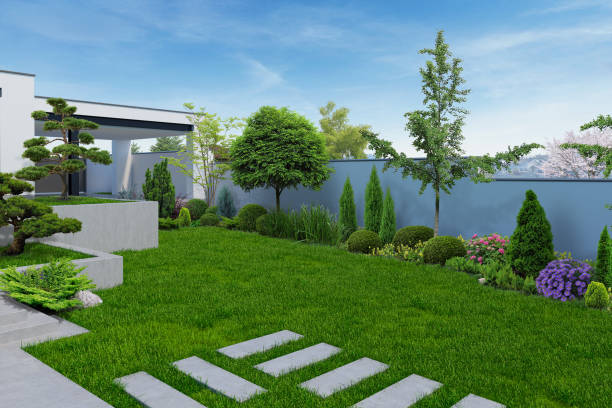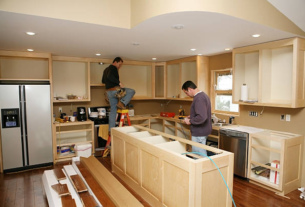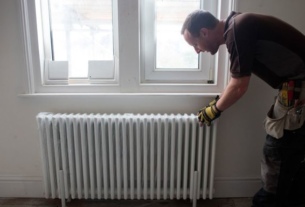Did you know that a well-landscaped yard can increase your home value between 5.5 and 12.7%? It certainly makes sense, because we all love driving through a neighborhood with manicured lawns, shady trees, and colorful blooms.
Common HOA Landscaping Guidelines
A neighborhood with a Homeowner’s Association (HOA) usually puts an emphasis on yard care in an effort to increase curb appeal throughout the community. Additionally, some HOAs include yard maintenance in their monthly fees, so they have guidelines for residents to follow. While each HOA across the United States will have its own covenants, conditions, and restrictions (CC&Rs), there are some common guidelines many follow when it comes to landscaping.
if you’re interested in learning more about the duties of an HOA, check out THIS article from Rhino Property Management.
Plant Palette
Have you ever strolled a neighborhood and been dazzled by the cohesive color palette on home exteriors and in the yards? It may not be a coincidence that the colors repeat themselves throughout the yards you’re seeing.
May HOAs have an approved color palette when it comes to plants in residents’ yards. It not only promotes a cohesive look to the neighborhood, but it can ensure homeowners or renters are using native species of vegetation in their gardens. If you’ve ever had trouble deciding what plants to use in your yard, choosing from an HOA-approved list might just be a dream come true for you!
Hardscaping
The color palette requirements may also extend to hardscaping materials, such as rock, wood, or even asphalt. If a resident wants to make improvements like adding a fence, installing a retaining wall, or having a pathway put in, it will likely require prior approval from the HOA. Additions to decks or patios usually need to be approved as well to ensure the right materials are used, and that they’ve done to the specifications required by the HOA.
Much like the color palette encouraged for vegetation, defining acceptable hardscape materials is in an effort to increase cohesion throughout the neighborhood, and ensure the best materials are used for the climate.
Lawn Decor
It’s not uncommon for homes in HOAs to be subject to restrictions regarding lawn furniture and decor. A homeowner may need approval before adding a bird feeder or water feature to either the front or back yard. Also, homeowners may only be permitted to have patio furniture in their backyards rather than their front yards to maintain the desired neighborhood aesthetic.
Plot Use
Before you clear a patch of lawn to add a home garden, check the HOA’s CC&Rs regarding plot use! Personal gardens may not be permitted, or they may only be allowed as container gardens. It’s not only a matter of appearance, but of resale value as well. Or, maybe your neighborhood backs up to wooded areas and your garden would attract undesirable wildlife to your yard; there are myriad reasons why a veggie patch may not be permitted at a residence within an HOA.
Plant Removal
Often, the HOA will determine if plants need to be removed in the community. However, if a resident wants a tree removed due to its health or how it affects their property (too much shade, dropping sticky sap, etc…) it shouldn’t be done without consulting with the HOA first. Trees in good health add value to a community, so an HOA may have a regulation in place that attempts to protect that value by restricting removal without approval.
What’s the Responsibility of the Resident?
Whether you own your own or rent it, if it’s located in an HOA, it’s important to know what is resident responsibility vs what is HOA responsibility. Some residents assume the HOA only maintains common areas, such as around the community pool or along the sidewalks. Others may be surprised to find the HOA fees they’re paying cover snow removal, lawn mowing, and front yard flower beds.
Whatever the case, the only way to find out is to ask. In a master-planned community like Cadence in Henderson, Nevada, there are a lot of common areas. So, one might assume the landscaping company contracted with the HOA focuses on the 50-acre Central Bike, walking trails, and areas surrounding the splash pad. Before making that assumption, ask about your specific home, and what your responsibilities are for the yard around it. There are over 2,000 acres in Cadence, and nine different builders have contributed to over 2,000 homes. Each mini-community within Cadence may have its own yard expectations.
Common Regulations to be Met
Regardless of who is caring for what in an HOA. There are often common expectations that need to be met to avoid citations.
- How often the grass is cut
- How trees and bushes are pruned
- Low limbs may reach to the ground
- How flower beds are mulched
- How often yards are watered
- and what type of, pest control is administered
Attend your regular HOA meetings if you ever have questions or concerns about how this yard maintenance is being carried out. It’s a two-way street; if the HOA feels you’re not fulfilling your responsibilities, you can be cited or fined. If you feel the HOA is not fulfilling the duties your HOA fees pay for, you can address the issue.
Making the Most of Your Space
Depending on where you live, you may have a small outdoor space to call your own that you’d like to maximize. Maybe the HOA regulations only extend to a home’s front yard, and the backyard can be a personalized oasis.
Cottonwood Landscapes has tips for maximizing a small space HERE, so you can get ideas for going vertical, hardscaping, and making a space inviting for guests.
TIPS FOR PERSONALIZING YOUR SPACE
Staring at a blank canvas can be intimidating. After you’ve checked with your HOA regarding any regulations for your space, here’s how to personalize it.
Consult a Profressional
You don’t have to design your yard by yourself. Sometimes you need a second set of eyes to create a vision for your yard.
Add Depth
Using the guidelines provided by your HOA, be sure to add depth to your planting and hardscaping. Layer tall, medium-height, and low-growing vegetation for added visual interest. Plant seasonal flora so there’s always something green or in bloom in your yard. Mix and match hardscaping elements with vegetation for variety.
Create Privacy
If fencing in your HOA isn’t an option, look into natural barriers such as ornamental grasses, shrubbery, canvas sails, or trellises. Sometimes as long as HOA-hired landscapers can access yards and paths for mowing and shoveling. Less permanent fence-like privacy structures are permitted.
In order to have the yard of your dreams within your HOA community, it usually boils down to communication. Before you sell your house or purchase or rent a home that’s governed by an HOA, ask specific questions about yard maintenance. Know what you’re getting into before signing on the dotted line. And also keep the lines of communication open if you want to make changes in the future. Many people love the convenience an HOA offers when it comes to landscaping, while others prefer to have free range. Either way, it’s up to you to practice due diligence when buying or renting a home.



